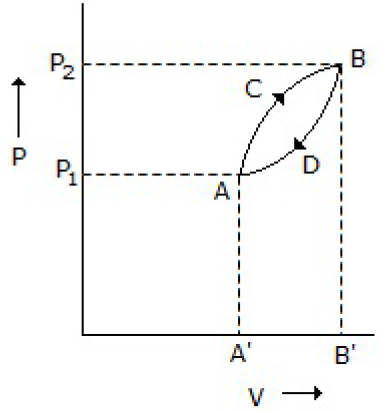Related Questions
Which of the following is not a reversible process?
Expansion of an ideal gas against constant pressure
Atmospheric pressure vaporisation of water at 100°C
Solution of NaCl in water at 50°C
None of these
Efficiency of a Carnot engine working between temperatures T1 and T2 (T1 < T) is
(T2 - T1)/T2
(T2 - T1)/T1
(T1 - T2)/T2
(T1 - T2)/T1
For an irreversible process involving only pressure-volume work
(dF)T, p <0
(dF)T, p = 0
(dF)T, p > 0
(dA)T, v >0
Clapeyron Equation deals with the
Rate of change of vapour pressure with temperature
Effect of an inert gas on vapour pressure
Calculation of ΔF for spontaneous phase change
Temperature dependence of heat of phase transition
Compressibility factor of a gas is
Not a function of its pressure
Not a function of its nature
Not a function of its temperature
Unity, if it follows PV = nRT
Free energy
Decreases in all spontaneous (or irreversible) processes
Change during a spontaneous process has a negative value
Remains unchanged in reversible processes carried at constant temperature and pressure
All (A), (B) and (C)
__________ decreases during adiabatic throttling of a perfect gas.
Entropy
Temperature
Enthalpy
Pressure
Chemical potential is a/an
Extensive property
Intensive property
Force which drives the chemical system to equilibrium
Both (B) and (C)
Any substance above its critical temperature exists as
Saturated vapour
Solid
Gas
Liquid
A thermodynamic system is taken from state A to B along ACB and is brought back to A along BDA as shown below in the P-V diagram. The net work done during the complete cycle is given by the area covered by

P1ACBP2P1
ACBB1A1A
ACBDA
ADBB1A1A
Compressibility factor (i.e., the ratio of actual volume of gas to the volume predicted by ideal gas law) for all gases are
Always greater than one
Same at the same reduced temperature
Same at the same reduced pressure
Both (B) & (C)
Ideal refrigeration cycle is
Same as Carnot cycle
Same as reverse Carnot cycle
Dependent on the refrigerant's properties
The least efficient of all refrigeration processes
For the gaseous phase chemical reaction, C2H4(g) + H2O(g) ↔ C2H5OH(g), the equilibrium conversion does not depend on the
Steam to ethylene ratio
Temperature
Pressure
None of these
Which of the following is not an intensive property?
Volume
Density
Temperature
Pressure
For an isothermal reversible compression of an ideal gas
Only ΔE = 0
Only ΔH =0
ΔE = ΔH = 0
dQ = dE
In a homogeneous solution, the fugacity of a component depends upon the
Pressure
Composition
Temperature
All (A), (B) and (C)
The extensive properties are
Volume, mass and number of moles
Free energy, entropy and enthalpy
Both (A) and (B)
None of these
A reasonably general expression for vapourliquid phase equilibrium at low to moderate pressure is φi yi P = Yi xifi° where, Φ is a vapor fugacity component, Yi is the liquid activity co-efficient and fi° is the fugacity of the pure component i. the Ki value (Yi = Ki xi) is therefore, in general a function of
Temperature only
Temperature and pressure only
Temperature, pressure and liquid composition xi only
Temperature, pressure, liquid composition xi and vapour composition yi
PVγ = Constant (where, γ = Cp/Cv) is valid for a/an __________ process.
Isothermal
Isentropic
Isobaric
Adiabatic
Law of corresponding states says that
Two different gases behave similarly, if their reduced properties (i.e. P, V and T) are same
The surface of separation (i. e. the meniscus) between liquid and vapour phase disappears at the critical temperature
No gas can be liquefied above the critical temperature, howsoever high the pressure may be.
The molar heat of energy of gas at constant volume should be nearly constant (about 3 calories)
Variation of equilibrium pressure with temperature for any two phases of a given substances is given by the __________ equation.
Gibbs-Duhem
Maxwell's
Clapeyron
None of these
Henry's law is closely obeyed by a gas, when its __________ is extremely high.
Pressure
Solubility
Temperature
None of these
Which law of the thermodynamics provides basis for measuring the thermodynamic property?
First law
Zeroth law
Third law
Second law
An ideal gas is taken around the cycle ABCA as shown in P-V diagram below: The work done by the gas during the cycle is equal to

12 P1V1
6 P1 V1
3 P1V1
P1 V1
Work done in an adiabatic process between two states depends on the
Rate of heat transmission
Initial state only
End states only
None of these
In the ammonia synthesis reaction, N2 + 3H2 2NH3 + 22.4 kcal, the formation of NH3 will be favoured by
High temperature
Low pressure
Low temperature only
Both low temperature and high pressure
Translational kinetic energy of molecules of an ideal gas is proportional to (where, T = absolute temperature of the gas)
T
√T
T2
1/√T
The shape of T-S diagram for Carnot Cycle is a
Rectangle
Rhombus
Trapezoid
Circle
Pick out the wrong statement.
A closed system does not permit exchange of mass with its surroundings but may permit exchange of energy.
An open system permits exchange of both mass and energy with its surroundings
The term microstate is used to characterise an individual, whereas macro-state is used to designate a group of micro-states with common characteristics
None of the above
What is the value of ln y (where y = activity co-efficient) for ideal gases?
Zero
Unity
Infinity
Negative
